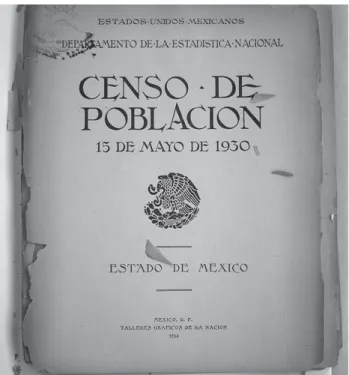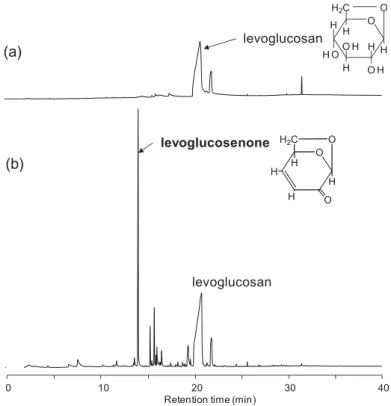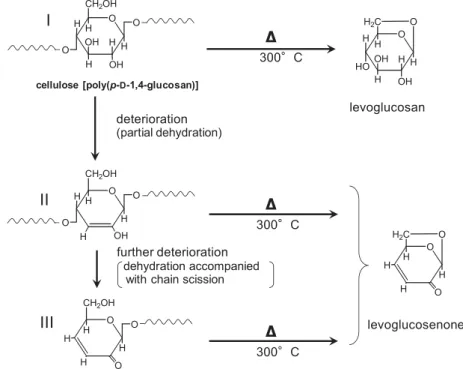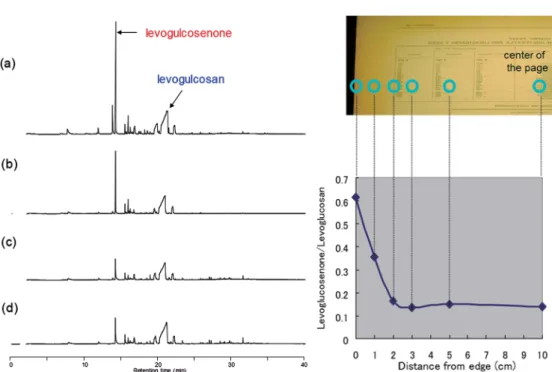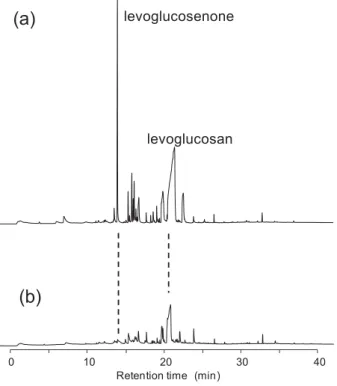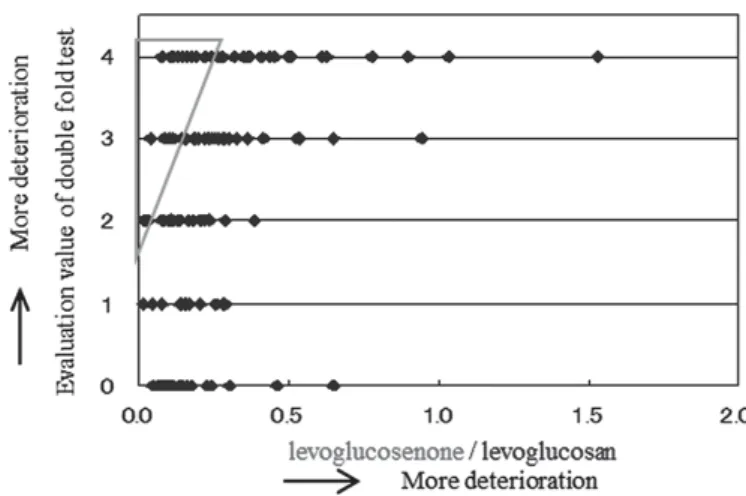Evaluation of Acidic Paper Deterioration in Library Materials by Pyrolysis‑Gas
Chromatography
著者(英) Hajime Ohtani
journal or
publication title
Senri Ethnological Studies
volume 85
page range 11‑19
year 2013‑12‑25
URL http://doi.org/10.15021/00002424
11
Edited by Naoko Sonoda, Claude Laroque, Jeong Hye-young and Chen Gang
Evaluation of Acidic Paper Deterioration in Library Materials by Pyrolysis-Gas Chromatography
Hajime OHTANI
Nagoya Institute of Technology, Japan
Pyrolysis-gas chromatography (Py-GC) was used to evaluate deteriorated acidic paper in old books. A tiny piece (ca. 0.25 mg) of deteriorated paper from each book was subjected to Py-GC measurement at a 300°C pyrolysis temperature. Levoglucosan and its dehydrated form levoglucosenone were typical degradation products, whereas primarily only levo- glucosan was observed in control samples of undamaged new paper. The relative intensity of levoglucosenone was much higher in samples taken at the heavily deteriorated marginal edge than in those taken from the center of the same page of an old book. Accordingly, levoglucosenone observed in the pyrogram can be used as a marker to evaluate the degree of deterioration of acidic paper. The formation of levoglucosenone can be attributed to the slow deterioration process of paper, in which the dehydration reaction plays an important role, accompanied by the chain scission of cellulose. The Py-GC method for paper evaluation was also applied to clarify the effect of storage conditions on the deterioration of paper mate- rials and to evaluate the long-term deterioration of the British Parliamentary Papers (1801–
1986) collected at the Kyoto University Library.
1. Introduction 2. Experimental
2.1 Paper samples
2.2 Conditions for Py-GC measurements 3. Results and discussion
3.1 Key product for acidic paper deterioration
3.2 Evaluation of degree of paper deterioration by Py-GC 3.3 Effect of storage conditions on acidic paper deterioration
3.4 Systematic evaluation of deterioration in the British Parliamentary Papers
4. Conclusion
12 Hajime OHTANI
1. Introduction
A severe problem worldwide is the gradual and inevitable deterioration of paper in old books and documents stored in libraries. This problem is mostly caused by the acidic nature of the rosin-alum additive used for sizing since the late nineteenth century. Sulfate ions accompa- nied by protons liberated from the sizing agent attack paper materials. The pages of severely deteriorated books are very brittle and cannot be turned safely in an ordinary manner. To preserve and restore such degraded materials appropriately, the degree of deterioration must be evaluated.
Various mechanical tests are available for this purpose, but they usually destroy or damage historical library materials. Pyrolysis-gas chromatography (Py-GC) provides a simple but rapid and extremely sensitive analytical tool that requires only minute sample amounts, gen- erally on the sub-mg order. The procedure has been demonstrated to be successful for the characterization of various synthetic polymers and natural organic products (Tsuge et al.
2011) as well as photo-yellowing trigger compounds (Seino et al. 2004) and various addi- tives, applied in trace amounts, in paper (Yano et al. 1991, 1992; Ishida et al. 1994a, 1994b).
In this study, Py-GC was performed to evaluate the possibility of characterization of deteriorated paper in old books. The mechanism of deterioration of acidic paper is discussed, including the effect of storage conditions on the paper materials. Finally, the deterioration of the British Parliamentary Papers (1801–1986) was systematically evaluated.
2. Experimental 2.1 Paper samples
A selected page of an old book (Censo de Poblacion, published in 1932 in Mexico) was used as a deteriorated paper sample. Figure 1 shows a photograph of the cover page of the book, which was deeply colored, and the mechanical strength of the sampled paper was quite weak, with a folding endurance (number of double folds until breakage) of 20.
In addition, the same page near the cover of two copies of the booklet Shiryoukan Shozoushiryo Mokuroku (published in 1952 in Japan) stored under different conditions in the National Institute of Japanese Literature located near Tokyo was also tested (Fig. 2). The booklet on the left in Figure 2 was stored wrapped in paper in a stock room without air- conditioning and was in much better condition than the one on the right, which was placed on the open bookshelf for daily use. It was referenced routinely in an air-conditioned room during working hours and was subject to abrupt fl uctuations of temperature and relative humidity.
In addition, randomly chosen pages in selected 140 volumes of the British Parliamentary Papers (1801–1986) were also subjected to analysis by Py-GC and the results compared with double-fold test measures of deterioration.
2.2 Conditions for Py-GC measurements
A temperature programmable microfurnace pyrolyzer (Frontier Lab, PY-2020D, Koriyama, Japan) was attached to the injector (at 300°C) of a GC (HP 5890, Palo Alto, CA, USA)
Fig. 1 Photograph of the cover page of Censo de Poblacion, published in 1932 in Mexico
Fig. 2 Photograph of two copies of an old booklet (Shiryokan Shozoushiryo Mokuroku, 1952, Japan) preserved under different conditions: left, stored wrapped in paper in a stock room; right, placed on an open shelf for daily use (Ohtani et al. 2009)
14 Hajime OHTANI
equipped with a fl ame ionization detector. A few small pieces of the paper sample (total weight, ca. 0.1 mg) punched by the middle size of a Harris micropuncher (Frontier Lab, HMP-0.75D, Koriyama, Japan) from a prescribed area of the test sheet (page) were placed into a platinum sample cup. The sample in the cup was dropped into the center of the pyro- lyzer heated at 300°C under a helium carrier gas fl ow (50 mL min–1). A part of the fl ow (1 mL min–1) reduced by a splitter was introduced into a metal capillary separation column (Frontier Lab, Ultra ALLOY+-5; 30 m long × 0.25 mm i.d., Koriyama, Japan) coated with immobilized 5% diphenyl-95% dimethylpolysiloxane (0.25μm fi lm thickness) together with pyrolysis products. The column temperature was initially held at 40°C for 5 min and then programmed to 280°C at a rate of 10°C min–1. For peak identifi cation, the pyrolyzer was also attached to a gas chromatography-mass spectrometry (GC-MS) system (JEOL, AM-II 150, Tokyo, Japan) with electron ionization at 70 eV (Ohtani et al. 2009).
3. Results and discussion
3.1 Key product for acidic paper deterioration
Figure 3 shows a typical pyrogram of deteriorated paper, sampled from a highly deteriorated edge of a page in the damaged book (1932, Mexico) and an undeteriorated reference sample.
Fig. 3 Pyrograms of paper samples at 300°C: (a) an undeteriorated reference sample; (b) a highly deteriorated sample (1 cm from the edge of a page inCenso de Poblacion, 1932, Mexico) (Ohtani et al. 2009)
The undeteriorated paper (commercially available fi lter paper) showed a peak of 1,6- anhydro-p- -D-glucopyranose (levoglucosan), which is a typical pyrolysis product of cellu- lose (Tsuge et al. 2011). Some additional products were observed in the highly deteriorated paper. Among these products, the most intense peak was identifi ed from the observed mass spectrum as 1,6-anhydro-3,4-dideoxy-β-D-glycero-hex-3-enopyranos-2-ulose (levoglucose- none).
Figure 4 shows a possible deterioration mechanism of acidic paper based on the observed pyrograms along with the related pyrolysis products. In the case of undeteriorated paper (I), levoglucosan is typically formed from cellulose through pyrolysis (Ohtani et al. 2009). The levoglucosenone observed specifi cally in the deteriorated paper sample corresponds to a dehydrated product of levoglucosan through the elimination of two water molecules, and the deterioration under an acidic condition is closely related to the dehydration reaction in the glucose unit of cellulose. A dehydrated anhydroglucose unit (II) of the chain may easily form levoglucosenenone. Further dehydration leads to a chain scission in the chain (III), which is the cause of the loss of strength of the paper. Also the type III unit is prone to levoglucose- none formation. Therefore, the levoglucosenone formed from the dehydrated parts of cellu- lose through pyrolysis refl ects the degree of chemical changes in the paper.
3.2 Evaluation of degree of paper deterioration by Py-GC
Figure 5 shows the differences in the observed pyrograms for the deteriorated paper sample
Fig. 4 Possible deterioration mechanisms of acidic paper along with related pyrolysis products (Ohtani et al.
2009)
16 Hajime OHTANI
(1932, Mexico) taken at various locations on the same page, along with the relationship between the relative peak intensities of levoglucosenone to levoglucosan and the distance of the sampling position from the edge of the given page.
Generally, paper deterioration was much more severe at the marginal part of page than at the center. Correspondingly, the levoglucosenone peak was the most intense at the edge (Fig. 5a), and its relative intensity gradually decreased toward the center of the page. The fact that levoglucosenone was still observed in the central part of the page (Fig. 5d) indicates that the paper sample was markedly damaged even in the center. Interestingly, the change in the peak intensities of levoglucosenone was quite consistent with the variation in coloration observed in the deteriorated paper sheet (Fig. 5 photo). This demonstrates that the relative peak intensity of levoglucosenone observed in the pyrogram is a good measure of the degree of deterioration for acidic paper.
3.3 Effect of storage conditions on acidic paper deterioration
The archival materials that were published more than 50 years ago but kept under different conditions (Fig. 2) were characterized by Py-GC to clarify the effect of the storage conditions on acidic paper deterioration.
Figure 6 shows the pyrograms of the paper pieces sampled from corresponding positions in the same page from each booklet (Ohtani el al. 2009). The levoglucosenone peak is high
Fig. 5 Pyrograms of deteriorated paper sampled at various positions in a page of an old book (Censo de Poblacion, 1932, Mexico): (a) edge; (b) 1 cm from the edge; (c) 2 cm from the edge; and (d) 10 cm from the edge (center), with the relationship between the relative peak intensity of levoglucosenone and sam- pling distance from the edge is also shown
in the case of the highly damaged (open-shelf) book and is negligibly low for the stored copy.
This result clearly indicates that the damage in the open-shelf book was brought about not only by the mechanical stress of daily use but also through chemical deterioration produced by light exposure. The fl uctuation in environmental temperature and humidity also probably contributed to the degradation.
3.4 Systematic evaluation of deterioration in the British Parliamentary Papers
Deteriorations in the British Parliamentary Papers, which are collected at the Kyoto Univer- sity Library, were also systematically evaluated by Py-GC.
Figure 7 shows the relationships between the relative peak intensities of levoglucose- none to levoglucosan observed in the pyrograms of the sample pages and the evaluation val- ues obtained through the double-fold test for the corresponding pages. Larger values for the double fold test (maximum of 4) indicate a lower mechanical strength of the test sheet.
Although the values were roughly correlated with each other, some paper samples showed low mechanical strength despite a low levoglucosenone intensity. This result suggests that, in addition to dehydration, other processes such as oxidation, hydrolysis and depolymeriza- tion might contribute to the long-term deterioration of acidic paper.
Fig. 6 Pyrograms of paper samples from identical books stored under different conditions as shown in Fig. 2:
(a) open shelf and (b) stored and wrapped. The books were sampled at equivalent positions of the same page (Ohtani el al. 2009)
18 Hajime OHTANI
4. Conclusion
Levoglucosenone and levoglucosan were present in pyrograms of deteriorated acidic paper, whereas only levoglucosan was observed in undeteriorated samples. The relative intensity of levoglucosenone corresponds to the damage level of the old paper samples. Accordingly, levoglucosenone observed in the pyrogram can be used as a marker to evaluate the degree of deterioration of acidic paper. The formation of levoglucosenone from deteriorated paper through pyrolysis suggests that dehydration reactions play an important role, accompanied by the chain scission of the cellulose main chain during acidic paper deterioration. The Py-GC evaluations of the booklets in relatively good and deteriorated conditions demonstrated that the ageing was strongly affected by storage conditions, but the dehydration reaction may not be the only contributor to deterioration in acidic paper.
References
Ishida, Y., H. Ohtani, S. Tsuge, and T. Yano
1994a Determination of Neutral Sizing Agents in Paper by Pyrolysis-Gas Chromatography. Ana- lytical Chemistry 66(9): 1444–1447.
Ishida, Y., H. Ohtani, T. Kato, S. Tsuge, and T. Yano
1994b Determination of Rosin Sizing Agents in Paper by Pyrolysis-Gas Chromatography Com- bined with On-line Methylation.Tappi Journall77(3): 177–183.
Ohtani, H., T. Komura, N. Sonoda, and Y. Taguchi
2009 Evaluation of Acidic Paper Deterioration in Library Materials by Pyrolysis-Gas Chroma- tography. Journal of Analytical and Applied Pyrolysis 85(1–2): 460–464.
Fig. 7 Relationship between the results of the double-fold test and relative intensity of levoglucosenone in the observed pyrograms for about 140 selected volumes of the British Parliamentary Papers. The points within the triangle indicate samples that showed low mechanical strength and low levoglucosenone intensity
Seino, T., A. Yoshioka, M. Takai, Y. Kojima, Y. Ishikura, T. Ona, Y. Ishida, and H. Ohtani
2004 Characterization of Photo-Yellowing Trigger Compounds Repressing Paper Recyclability.
Transactions of the Materials Research Society of Japan 29(5): 2093–2096.
Tsuge, S., H. Ohtani, and C. Watanabe
2011 Pyrolysis-GC/MS Data Book of Synthetic Polymers:—Pyrograms, Thermograms and MS — of Pyrolyzates—. The Netherlands: Elsevier.
Yano, T., H. Ohtani, and S. Tsuge
1991 Determination of Wet-Strength Resin in Paper by Pyrolysis-Gas Chromatography. Tappi Journal 74(2): 197–201.l
Yano, T., H. Ohtani, S. Tsuge, and T. Obokata
1992 Determination of Neutral Sizing Agents in Paper by Pyrolysis-Gas Chromatography.Analyst 117(5): 849–852.
